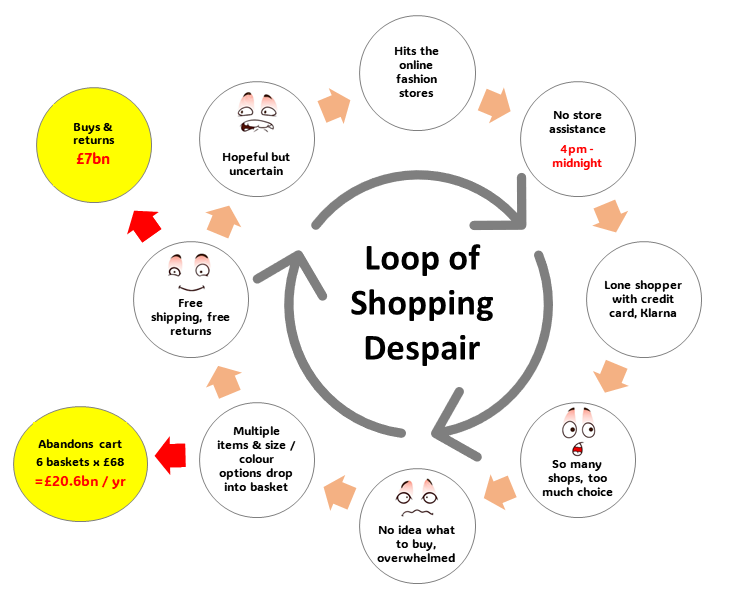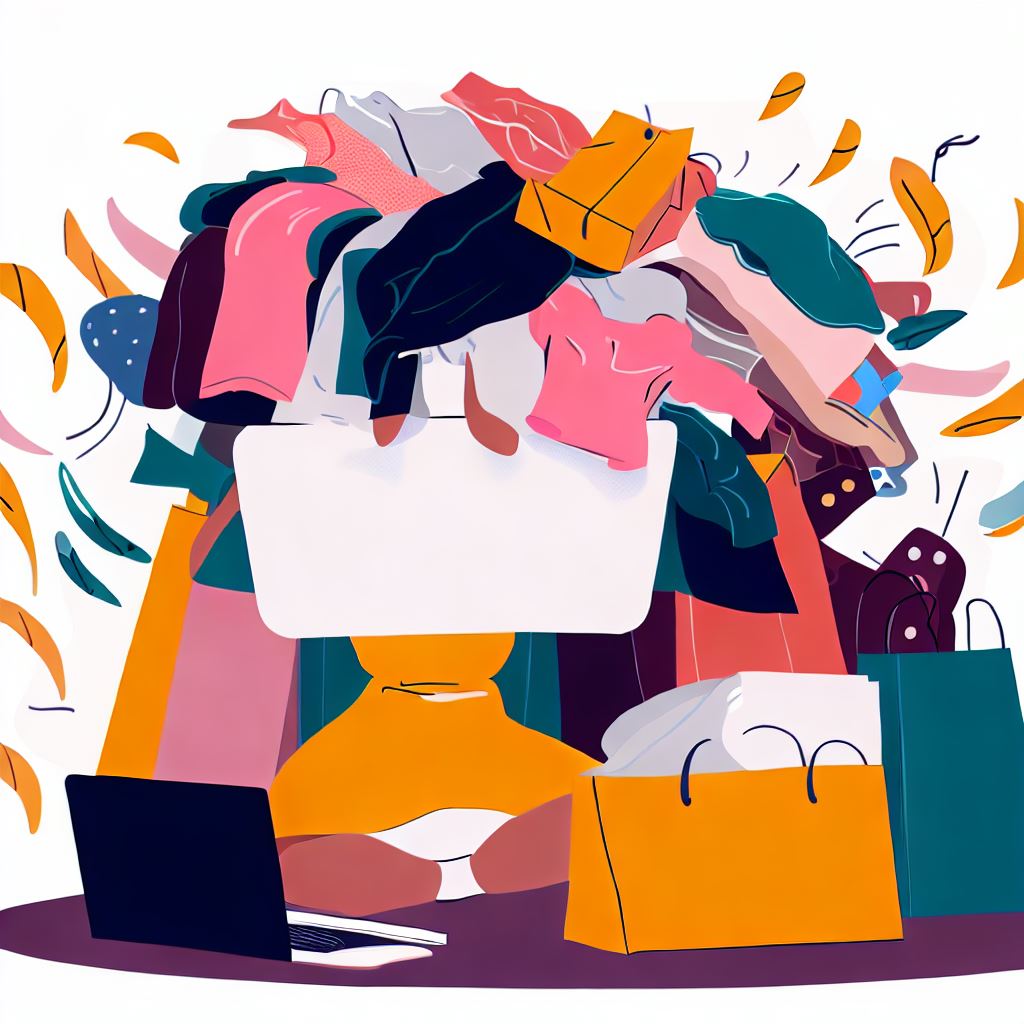BY CHRIS JONES | SEPTEMBER 25, 2023 | 7 MINUTE READ
In the high-stakes realm of fashion e-commerce, retailers grapple with seemingly omnipresent issues, including skyrocketing return rates, rampant cart abandonment, and fluctuating client retention, dramatically impeding revenue and profit margins. The crucial problem many retailers overlook is the uncertainty and overwhelming experience for many online shoppers. There are, however, emerging solutions from various tech providers seeking to revamp the online shopping paradigm and cultivate well-informed, confident consumers.
The Core Challenges
Fashion e-commerce retailers constantly battle high return rates, cart abandonment, and poor customer loyalty, costing the online fashion industry enormous sums.
Here are examples to understand the staggering costs involved.
1) Return Rates and Costs are high
United Kingdom
A Statista poll identifies fashion apparel as the highest rate of return of all purchase categories in the UK during June 2023 at 31%.
A study by KPMG estimates the cost of handling returns for online fashion purchases in the UK to be around £7bn per year.
USA
The US Postal Service reports that handling and processing costs businesses an average of $10 per return.
According to research by Shopify, return rates for online fashion purchases range from 30% to 50%, much higher than the average return rate of all online purchases of 20.8%, as reported in a study by the National Retail Federation (NRF) and Appriss Retail.
Other studies highlight increasing returns;
Forrester: The average return rate of clothing in 2021 was 30%.
Eco-Age: Average return rates may be as high as 40%.
KPMG: 50% return rates may be the norm for clothing retailers following the holiday period.
NRF estimates that $218bn (20.8%) worth of goods bought online were returned in 2021.
2) Abandoned Carts are highest for fashion
Statista reports that the average fashion website shopping cart abandonment rate reached 84.4% in 2021.
According to a Barclaycard survey, British shoppers abandon online baskets worth almost £30 a month, potentially resulting in more than £18bn in lost sales every year. Other surveys suggest the figure could be greater than £20bn.
3) Customer retention is low for online fashion
There are no studies on consumer retention rates in the fashion industry. However, some claims suggest the retention figure for fashion retailers could be as low as 26%, compared to an average customer retention rate of 70% - 80% across industries, as reported by Shopify.
According to Forbes, attracting new customers to fashion brands is becoming more challenging than ever. The traditional view is that attracting a new customer costs 6 to 7 times more than retaining an existing customer. However, consumers now expect brands to align with their values, such as sustainability and fair wages, so acquiring new customers is becoming more expensive, complicated, and demanding.

What are the causes?
If you asked for reasons for high return rates, you’ve usually received three ‘top’ answers;
The fit isn’t right.
Poor quality or damage.
I didn't like it.
These are all valid reasons – you can see the garment in an image, but it is often stylised, and you can’t try it on, see the detail, or feel the quality before buying.
However, many brands have made a great deal of effort to improve their sizing and quality of designs, materials, and products, and this often goes hand in hand with a PLM solution implementation as a point to review and reset size templates and apply as standards within a process workflow that provides better data, visibility, and collaboration.
Therefore, with better fit and higher quality, you’d expect consumers to return to a brand they can rely on, so return rates and retention would improve. This isn’t the case, so what else is happening?
Commentators point to ‘Bracketing’, the act of buying products with the intention of returning them. Eco-Age suggests this has become so common that 30%-40% of all clothes purchased online are returned due to bracketing.
However, what’s the cause of bracketing? Does it explain abandoned carts?
The Loop of Shopping Despair
Susanna Hancock, CEO of TAKE-ME-SHOPPING.ONLINE suggests that all these issues stem from the inherent uncertainty and information overload experienced by consumers when shopping online, which she dubs the "Loop of Shopping Despair". This phenomenon encapsulates the cycle of click, shop, basket, deliver, try on, and return, with consumers struggling with too many choices and insufficient knowledge of what suits them.
This behaviour is supported by voice of the consumer platforms that report that when aspirational choices are involved, it’s often the case that what the consumer said they wanted was not what they purchased.
The indecision at the heart of the ‘Loop of Shopping Despair” subsequently leads to high return rates, cart abandonment and inevitably low customer retention rates.

The Loop of Shopping Despair, provided by Susanna Hancock
Diverse Solutions
A variety of solutions are being implemented to resolve these issues. Firstly, as mentioned, many retailers have been working hard to improve fit and quality, yet high returns still need to be addressed. Therefore, some retailers have introduced a charge for returning items purchased online, with H&M charging £1.99 for returning items by post in the UK, only to be refunded if the item has a defect, whilst returning to a store remains free of cost for any item. Zara, New Look, Boohoo, Uniqlo, and Next have also introduced returns charges. It’s yet to be seen what effect this will have on those brands’ e-commerce sales and returns rates.
Several tech providers are developing innovative solutions to address these problems. Susanna Hancock says, "Integrating trained personal stylists and utilising science, psychology, and technology to personalise experiences at scale represent promising solutions. By providing personalised, assisted shopping experiences, these platforms empower consumers to make more confident and informed purchasing decisions, breaking the ‘Loop of shopping despair’ and reducing return rates and cart abandonment.".
Approaches showing promise
It’s already been reported that using product stylists in-store has tripled the average basket size, and an unbiased, trusted connection, supported by technical knowledge from a stylist, is why customer spend is almost “four times higher than the average transaction value”.
Can this approach be replicated online? This may be feasible if personal styling could be replaced by personalised customer service experiences driven by science and the principles of personal styling. Generative AI could be employed to scale the proposition.
However, we must still consider the human element; will this replace social influencers? Not in the short to medium term. One of my favourite article headlines provides an excellent overview – “TikTok made me Buy it”. It explains how the curated and aspirational fashion content on Instagram is being overtaken by the ‘unfiltered reality’ on TikTok. The TikTok fashion content is more accessible and has become more influential.
This points to the need for the human element in online personalised customer service experiences.
Impactful Technologies
Artificial Intelligence: Adopting AI technologies can foster personalised shopping experiences, potentially reducing returns by aiding consumers in making well-informed purchasing decisions. It could be the game-changer in offering personalised advice at scale, addressing each consumer's individual needs and preferences. However, as we’ve learned from Instagram vs. TikTok, we need to introduce the human element of reality into the experience and learning dataset.
Social Media Integration: Leveraging platforms like TikTok and Instagram enables brands to connect with consumers and drive organic growth. By tapping into the insights and data from influencer-based sales and potentially including them as examples within the customer service experience, brands can drive better customer experience, create incremental revenue and better understand consumer preferences and buying behaviour.
Data Analysis: Employing sophisticated data analysis tools is essential to aid retailers in understanding consumer wants and buying behaviour, thereby reducing returns caused by consumer buying behaviour. Proper utilisation of consumer insights can help brands be on-trend, assist in customer buying experience, and reduce errors in inventory management and product offerings.

The Road Ahead
While some of these solutions were met with scepticism initially, the mounting severity of the challenges in the current e-commerce landscape renders these innovations increasingly crucial. As more brands and retailers become aware of the paramount importance of these issues, the assimilation of such pioneering solutions becomes inevitable.
Conclusion
The fashion e-commerce landscape is teeming with challenges, but innovative solutions from various tech providers offer a beacon of hope. By leveraging advancements like AI and integrating diverse technologies to incorporate the human element and ‘fashion reality’, these solutions aim to resolve the inherent problems in fashion e-commerce, ranging from high return rates and cart abandonment to low client retention. The quest is to boost profits and elevate the shopping experience, making it more streamlined, informed, and enjoyable for customers. Whether these solutions can effectively reshape the fashion customer shopping experience and drive a substantial uplift in sales and customer satisfaction remains to be seen. Still, they undoubtedly represent significant strides toward a more customer-centric fashion e-commerce ecosystem.
Author Chris Jones
For over three decades, Chris has helped global brands, retailers, and manufacturers align people, processes, and technology, driving transformation projects to maximise business impact.
This article is also published on the website: Navigating Fashion E-Commerce Challenges: High Returns, Cart Abandonment, and Low Customer Retention (www.LinkedIn.com)

